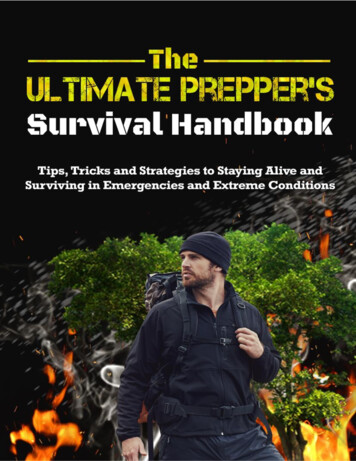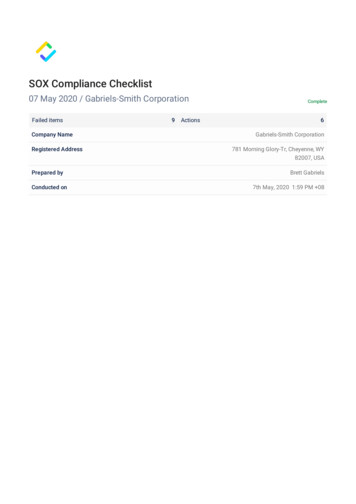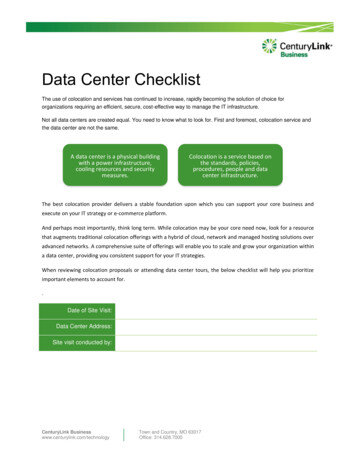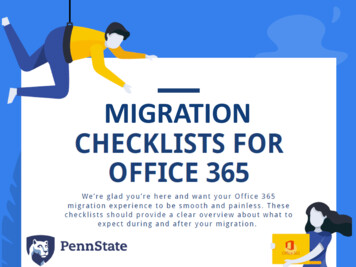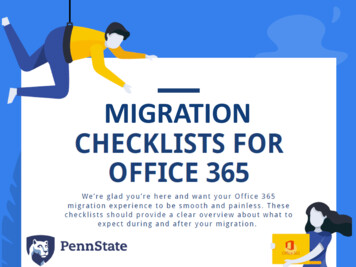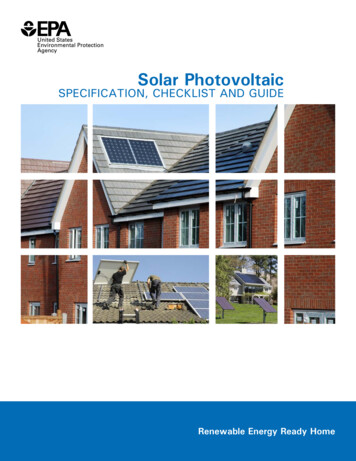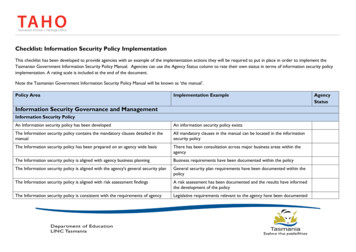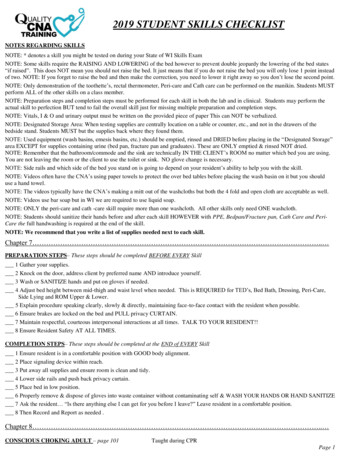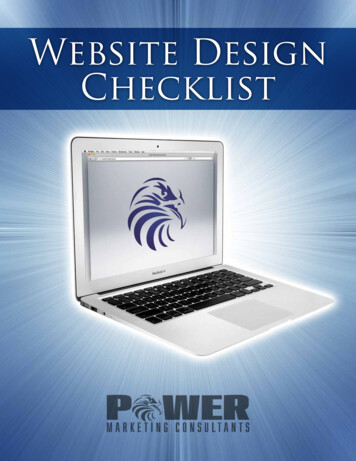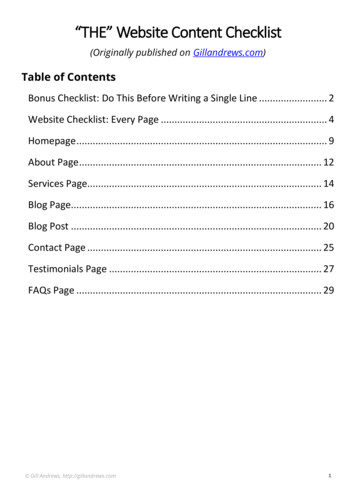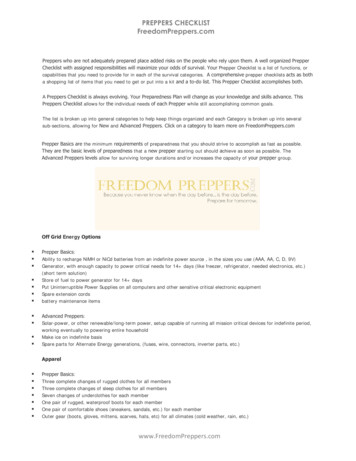
Transcription
PREPPERS CHECKLISTFreedomPreppers.comPreppers who are not adequately prepared place added risks on the people who rely upon them. A well organized PrepperChecklist with assigned responsibilities will maximize your odds of survival. Your Prepper Checklist is a list of functions, orcapabilities that you need to provide for in each of the survival categories. A comprehensive prepper checklists acts as botha shopping list of items that you need to get or put into a kit and a to-do list. This Prepper Checklist accomplishes both.A Preppers Checklist is always evolving. Your Preparedness Plan will change as your knowledge and skills advance. ThisPreppers Checklist allows for the individual needs of each Prepper while still accomplishing common goals.The list is broken up into general categories to help keep things organized and each Category is broken up into severalsub-sections, allowing for New and Advanced Preppers. Click on a category to learn more on FreedomPreppers.comPrepper Basics are the minimum requirements of preparedness that you should strive to accomplish as fast as possible.They are the basic levels of preparedness that a new prepper starting out should achieve as soon as possible. TheAdvanced Preppers levels allow for surviving longer durations and/or increases the capacity of your prepper group.Off Grid Energy Options Prepper Basics:Ability to recharge NiMH or NiCd batteries from an indefinite power source , in the sizes you use (AAA, AA, C, D, 9V)Generator, with enough capacity to power critical needs for 14 days (like freezer, refrigerator, needed electronics, etc.)(short term solution)Store of fuel to power generator for 14 daysPut Uninterruptible Power Supplies on all computers and other sensitive critical electronic equipmentSpare extension cordsbattery maintenance itemsAdvanced Preppers:Solar-power, or other renewable/long-term power, setup capable of running all mission critical devices for indefinite period,working eventually to powering entire householdMake ice on indefinite basisSpare parts for Alternate Energy generations, (fuses, wire, connectors, inverter parts, etc.)Apparel Prepper Basics:Three complete changes of rugged clothes for all membersThree complete changes of sleep clothes for all membersSeven changes of underclothes for each memberOne pair of rugged, waterproof boots for each memberOne pair of comfortable shoes (sneakers, sandals, etc.) for each memberOuter gear (boots, gloves, mittens, scarves, hats, etc) for all climates (cold weather, rain, etc.)www.FreedomPreppers.com
Preppers ChecklistFreedomPreppers.com Spare shoe & boot laces Advanced Preppers:Seven sets of rugged clothes for each memberFourteen changes of underclothes for each memberSpare boots (rugged and waterproof)Spare comfort shoesAbility to make/repair clothesAbility to make/repair boots and shoesQuantity of various materials for repairs and creation of clothingSecond (spare) set of outer gear for all climatesCommunications Prepper Basics:Tactical Communications (0 – 5 miles), generally a handi-talkie (FRS, GMRS, Ham, CB, etc.), transmit and receive, withextra batteries (see also alternate energy)Shortwave radio with SSB capability, for general listening of world eventsBasic computer to access the Internet and review files (.doc. .pdf. .html. etc.) {it should be obvious that an Internetconnection goes along with this}AM/FM radio, battery operated (TV sound optional, but might be worthwhile if you are close to a TV broadcast tower thatcan run on emergency power)Plans and equipment for making expedient antennas (see Information and Plans)Radio and computer manuals and backup discs (see Information and Plans)If you have a cell phone, have a 12VDC charging cord for it, and a spare battery for itPocket list of contact numbers for family, friends, team members (see also Information and Plans)Long distance phone calling card that doesn’t expirePocket list of frequencies (see also Information and Plans)USB drive containing pocket computer system (OS, files, programs, PGP, etc.)USB drive containing your data filesDoor Intercom for communicating with people outside your door, while staying safe inside Advanced Preppers:Short-distance Communications (up to 50 miles) (generally, a mobile ham VHF/UHF radio and a vehicle or yagi antenna),transmit and receivePacket radio for short-distance digital communications (can be particularly useful for local Groups/Teams/Family Units)Long-distance communications (greater than 50 miles), generally ham HF, transmit and receiveHam Radio Email, like Wavemail or Winlink/Netlink over HF and possibly VHF (Packet)Satellite phone Notes:Always store your electronics in Faraday Cages when not in use.www.FreedomPreppers.com
Preppers ChecklistFreedomPreppers.comDefense (Safety and Security) Prepper Basics:Security system that monitors home inside perimeterMonitoring system so that you know when someone has breeched key areas of your propertyOutside floodlights on motion sensors covering the outside perimeter of home and any other key areas on propertyPut out small fires (a fire extinguisher for kitchen, garage and every level of the home)Basic defensive firearms so that every able person can defend the home, with adequate ammunition supplyEvery handgun has a holster, every rifle and shotgun has a sling; cases for all firearms500 rounds for every firearm that is in working condition (defensive ammunition)500 rounds of training ammo for each firearmThree magazines or 30 clips for every firearm that uses one (yes, there’s a difference between clips and magazines)Cleaning gear for all firearmsSmoke & carbon monoxide detectors on all floors Advanced Preppers:Camera surveillance around home, complete 360 degreesMotion and seismic sensors monitoring perimeter and other key areas of propertyExternal fire suppression systemSpare parts for every firearm, along with the knowledge to repair itSpare magazines and clips for every firearm that uses them (10 magazines and 300 clips, at your discretion)Spare cleaning gear for all firearms1000 rounds for every firearm (defensive ammunition)1000 training rounds for each firearmReloading equipment and supplies for each of your main calibers5000 rounds for your main battle rifle.22 LR training rifle and 10,000 rounds of good quality .22 LR ammunitonAdd laminate to exterior windows (resists break-ins, etc.)Hardened Saferoom, from physical assaults (weather, crime, etc.)Night Vision (mono- or binocular) Notes:You can’t have too many fire extinguishers. You need to be able to put out a fire quickly, especially if there is no firedepartment available.Yes, it seems like a lot of ammunition, but every year our freedoms erode a little bit more. Better to have it and not needit, than to need it and not have it (that pretty much goes for everything on this CC list). Financial Preparedness Prepper Basics:Pay one month of bills with cash on handSupply of hard currency (silver, gold, etc.) Advanced Preppers:Pay three months or more of bills from cash on hand; increase to 6 months when possibleSupply of barter goodsAbility to capitalize on opportunities (like, group buys or cheap land after a crisis/pandemic)Know the silver content of junk silver and the gold content of various coins and how to convert that into current marketvalueKnow how to calculate and determine specific gravity for various metals (how to spot fake silver and gold) www.FreedomPreppers.com
Preppers ChecklistFreedomPreppers.com Notes:Hard currency amounts at your discretion, although it may be worthless. Use gold to store larger amounts of wealthand silver for smaller amounts. Silver is also better in a barter environment.Survival Medicine Prepper Basics: Need to perform the following for a 30-day periodPreventativeBlock Sun UV raysRepel (keep away) insectsBlister pre-treatmentProtect care-giver from infection while treating othersTake CPR and other First-Aid coursesMaintain good dental hygiene practicesImmediate ResponseCPRClear the airway / Start the breathingStop bleedingSoothe burnsTreat bite and stingsRemove splinters, stingers, etc.Remove venomDiagnosePatient assessment:Primary (ABC – Airway, Breathing, Circulation)Secondary, Head-to-Toe surveyDetermine body temperatureDetermine blood pressureDetermine heart rateRecognize signs and symptomsTreat and Protect WoundsDisinfect minor woundsWound irrigation and/or cleansingSplinting and limb immobilizationDress and bandage woundsDebride woundsClose lacerationsTemporary dental fillingsOngoing CareRelieve painReduce swellingReduce feverRelieve allergy symptomsStave off infection (antibiotics)Blister treatmentShock preventionDehydration preventionMuscle relaxerMiscellaneousIce & heat packs30 days of life saving prescription medications30 days of OTC and “maintenance” medicationswww.FreedomPreppers.com
Preppers ChecklistFreedomPreppers.com List of patient info for each person on their person & in BOBAdvanced Preppers: Need to perform the above for at least 90 days, plus the following additional capabilities:IV supplies to start one IV per person covered (including extras for missed sticks). 3 liters of solution per personKnowledge of blood types of all persons covered. Transfusion* compatibility planned. Transfusion capability for onetransfusion for each three people coveredDental careAdditional 90 days of life-saving prescription medicationsAdditional 90 days of non-critical and “maintenance” medicationsTake Advanced First Aid Courses, and yearly re-qualifiersNotes:Warning on transfusions: you can kill people easily if you do this wrong.DO NOT perform any medical treatment that you are not trained for.Food Storage & Cooking Off The Grid Prepper Basics:Stored food for 30 days (minimum, work up to 90 days) of food you eat everyday (store what you eat, eat what you store)Portable capability for minimum-prepared foods for 14 days (for traveling, short-term missions, etc.)Gather more food: hunt, fish, trap/snare, gather wild plantsDress and prepare gathered foodKeep perishable food cold using alternative energy methods for 30 days (see Alternative Energy)Disposable flatware for 30 daysOpen cans and other packagingCook food 3 times a day with alternate methods for 30 days (minimum, work up to 90 days)Have cookware that can be used over an open fire (pots, pans, kettles, etc.)Durable cooking utensils (including pots, pans, etc.)Equipment to cook over fire pit (grates, tripods, hooks, etc.)Recipes for making a variety of dishes from the food you storeSpices to make food more palatable, enjoyable, varied Advanced Preppers:One year’s worth of food, in any combination of everyday, minimum-prepared, and long-term storage foods, with theexperience and equipment to prepare itPortable capability for minimum-prepared foods for 30 days or more (for traveling)Grow food and harvest the seeds for the next plantingGrow and tend livestockPreserve food on indefinite basis (canning, smoking, jerking, etc)Keep perishable food cold using alternative energy methods for indefinite basisCook food 3 times a day with alternate methods for 1 year or moreDisposable flatware for 90 days (if continuous supply of water not obtained)Compost pile (see Sanitation) Notes:Minimum-prepared foods are those that require little or no cooking before eating.Flatware means plates, bowls, cups, spoons, forks, knives, napkins, etc. The idea of disposable flatware is to reduceconsumption of water and is typically for shorter-term events. Those with Advanced Preppers for alternate energy andwater will have less use for disposable flatware.Oils: make sure you have enough oil, lard, etc. on hand to cover the increase in pan-cooking.www.FreedomPreppers.com
Preppers ChecklistFreedomPreppers.comDisaster Preparedness Plans Prepper Basics:Acquire the proper insurance (home, renter, auto, health, life etc.) and safeguard the insurance plan and contactinformationDocument with pictures and/or video all possessions for insurance purposes, including writing down the serial numbers forguns and electronics.Post in a quick-access location the numbers for all emergency services (police, fire, ambulance, poison control, utilityservices), and include non-emergency numbers for the same services as well as family, friends, neighbors, etc.Post a list of important websites next to (or along with) the important phone numbers.Copies of personal information like birth certificates, SS cards, driver licenses, with current pictures, kept in fire safe.Have a written plan for what your actions will be for all conceivable eventsCreate a “Trigger Point” list that determines what plans need to be activated by event criteriaWrite down your plan for increasing your preparedness level and then use the plan to improve your state of preparednessA list of “last-minute purchase items” – in case you have time to “top off”Current inventoryResource materials (books, CDs, etc.) covering a wide range of topicsInstruction and repair manuals for everythingBackups of all important computer filesHard copies (printouts) of all critical information contained in computer filesBackup copies of your computer data on discs, USB flash drives, portable HDDsAn evacuation plan and prioritized grab listPlans and equipment for making expedient antennas (see Communications and Computing)Pocket list of contact numbers for family, friends, team members (see Communications and Computing)Pocket list of radio frequencies used (see Communications and Computing)Forms of entertainment (games, books, music, DVDs, CDs, MP3 players drawing, coloring, cards, football, frisbee,baseball/throwing ball, soccer ball, etc.) Advanced Preppers:Maps of surrounding area with extensive notes on routes and areas, including conditions at different times of the year (seeNavigation and Signaling)“Range cards” for your entire propertyDefense plan for entire property (who goes where, with what, does what, etc.)Triple backups of everything that’s important Personal ItemsPurseWalletIDWatchMoneyDaily carry items Notes:A “last-minute checklist” is generally a bad thing to implement. It’s better to have all the equipment and supplies on handbefore an event occurs.A Grab List is a list of items that you want to take with you in case you need to evacuate your home. The grab list shouldinclude everything that you would want to take, in priority order, so that you don’t have to try and remember while you’rescrambling to evacuate.Additional Entertainment considerations include games for kids, books (or reading material) for both education and learningresources, and books that show how to play more games (adult and children) using cards and other materials.It’s a good idea to keep important documents in a fire-resistant safeEntertainment items such as DVDs and CDs require the use of additional electronics and power, see appropriate categories. www.FreedomPreppers.com
Preppers ChecklistFreedomPreppers.com A “Trigger Point” is an event that you have pre-determined that will cause you to enact certain parts of your plan. Forexample, When virulent H5N1 reaches Canada or Mexico, your plan calls for you to do (whatever that might be).Lighting Prepper Basics:Instant-on light for each member (a decently bright flashlight that doesn’t burn through batteries, like an LED light)Area light (prefer safe LED or fluorescent instead of flame-based light)Spotlight, handheld, battery powered (see Alternate Energy) Advanced Preppers:Provide power to all normal light for home with Alternative Energy.Spare parts for all lights (bulbs, etc.) Notes:LED lights are preferred due to their lower consumption of battery power.Navigation & Signaling Prepper Basics:Maps of surrounding area, including topo, road atlas, etc. (see also Information and Plans)Compass, several quality instrumentsProtractor, rulers, grid squares, alcohol-erase markers, pencils, grease pencils etc. for map useWaterproof map cases, waterproofed maps, or maps covered in clear acetateAdvanced Preppers:GPS with built-in mapping software and direct-entry of information (coordinates, descriptions, etc), preloaded with theappropriate mapsPower support for GPS (see Alternative Energy)Notes:Prepping for Pandemics, Nuclear BioTerror Attacks Prepper Basics:N100 or P100 masks/filtersTyvek suits, including hood and over-bootsNitrile glovesAir filtration system capable of providing positive pressure in a saferoom area, with spare filtersEMP surge protectors on all sensitive equipmentDecontamination gear and supplies6 mil plastic in rolls and metal tape for safe rooms plus back up materialsPotassium Iodine/Iodate (KI) tablets, enough for a minimum of 14 days for each personLog book for noting exposures and readings, pencils, pens, calculator, ruler, log-log paperRadiological Instruction manual (like “Fallout Survival” by Druce D. Clayton; FEMA)Advanced Preppers:Air filtration system capable of providing positive pressure to whole house, with spare filtersEMP surge protectors on all house outletsRadiation meters (survey and dosimeters)Fallout shelterwww.FreedomPreppers.com
Preppers ChecklistFreedomPreppers.com Notes:Air filtration system filters needs to be at least HEPA and possibly ULPA.Quantities for the above are at your discretionDo not expect to stay in any room that has been sealed up with plastic for more than a few hours unless you are providingfiltered air into the room.Personal Hygiene & Sanitation Prepper Basics:Ability to handle human waste (ask yourself, “how and where am I going to go to the bathroom, and what am I going to dowith it once I’ve finished?” and “Do I have enough toilet paper?”)Two pairs of eyeglasses, both with current prescriptioneyeglass retaining strapsToiletries: Make sure you can do everything in the bathroom that you do on a daily basis, including:bath / wash (soap)brush teethtake care of dentureswash handsflossclean contactstrim nailscomb/brush hairmakeupshavedeodorant/antiperspirantKeep skin from drying (lotion)Tweeze hairClean earsBlow/clean noseDry self (towels)Feminine hygiene itemsGarbage disposal and recycle/reuseBucketsPlastic trash bags for waste both human and other to keep buckets cleanDeodorizers (Lysol, baking soda and vinegar, liquid porta-potty enzymes, etc.)Lice/Nit comb.Advanced Preppers:More of everything aboveRunning hot water (see Alternate Energy and Water)Running showersCompost garbage and wasteSpare bucketsMore plastic trash bagsNotes:www.FreedomPreppers.com
Preppers ChecklistFreedomPreppers.comPets & Animals Prepper Basics:30 days of stored food and water for each petAbility to handle pet waste if pet cannot go outside for 30 daysPet care needs, special medications, toys, etc for 30 daysLeashes and kennels for each animalTie-down stakePest control for petsShot / Vet recordUp-to-date shotsAdvanced Preppers:90 or more days of stored food and water for each pet, eventually working towards an indefinite supply for all petsAbility to handle pet waste if pet cannot go outside for 90 daysPet care needs, special medications, toys, etc for 90 daysPet first-Aid kitTested recipes for pet food from stored and/or gathered food sources, food scraps, etc.Notes:Shelter, Fire & Warmth Prepper Basics:Tent(s), enough tent space to contain all members and gearTarps, decent selection for general and miscellaneous useSleeping bag or other bedding of choice for each member, capable of keeping person warm in sub-freezing temperaturesAbility to make fire in, at least, 3 different waysSpare sheets and blanketsPillows (as needed)Advanced Preppers:Alternate heating source for homeLand Mobile – more durable and mobile sheltering system (e.g., camping trailer)Shelter building tools (see Tools, Repair and Utility)Shelter repair supplies: plywood, wood strips, plastic sheeting, screws, nails, etc. (see also Tools, Repair and Utility below)Pre-cut plywood for covering windows if you are in a Hurricane areaAbility to repair and maintain your home: Plumbing, Electrical, Carpentry, Roofing, Fencing, Concrete, Welding, etc.Notes:OPSEC & Camouflage Prepper Basics:Keep quiet – do not tell anyone about your preparedness plans, equipment or suppliesTeach your children not to talk about your preparedness plans, equipment or suppliesHave ready and plausible reasons for what you’re doing (”I’m buying all this food for the church cookout this weekend.”)Advanced Preppers:Notes:www.FreedomPreppers.com
Preppers ChecklistFreedomPreppers.comTools, Repair & Utility Prepper Basics:Buckets, with and without lidsBasic socket setBasic screwdriver setBasic wrench setBasic set of saws (wood, metal, etc.)Basic set of filesBasic wrench setMulti-meterTarp and plastic sheeting for temporary repair of roof, windows, and siding from storm damage. Large-head nails and woodstrips to attach themMulti-tool, quality e (bailing and electrical)TwineFusesCrimp connectorsScissors (need several pair for different tasks; a good set of scissors is indispensable)Soldering ironSolderDrill and drill bitsMeasuring tool (tape measure, carpenter’s rule, etc.)Repair/Mend clothingSewing kitClothes pins, woodenEyeglass repair kit Advanced Preppers:Gather & prepare fuel (axes, saws, splitter, etc.)Supply of nails, screws, and some lumber for structural repair of houseParts & tools to repair critical plumbing itemsSpare buckets, with and without lidsWelding setup Notes:This is one of the exceptions where this lists actual items. The reason is that the tool is often the action; for example, it’seasier to say “hammers” instead of “ability to hammer.”Some of the items above may require the use of electrical power (see Alternate Energy) www.FreedomPreppers.com
Preppers ChecklistFreedomPreppers.comTransportation Prepper Basics:Keep all vehicles in good repairFour wheel drive on main vehicle, or traction-enhanced (locking differentials, etc.)Main vehicle needs to be able to carry everyone in family, including a minimum of gear and supplies for 1 weekMain vehicle needs to run on standardized fuel (gasoline, diesel), not specialized fuel (high octane, bio-mix, propane,etc.)Stored fuel for one full tank (e.g., if your vehicle’s tank holds 20 gallons, store 20 gallons) in man-portable containers‘Fix a flat’ or SlimeSelf-vulcanizing plug kitAir compressor (12 VDC)Hose clamps, various sizes (or hose wrap or duct tape)Siphon hoseFunnels (keep in mind that a funnel for your fuel tank will probably be different from the ones that you use under the hood)Full-sized spare tireEmergency road equipment (flares, warning reflectors, etc.)Navigation (maps, GPS, etc.), stored in vehicleBasic spare parts (hoses, belts, sparks plugs, fasteners, etc.)Extra fluids (oil, coolant, transmission fluid, washer fluid, etc.)Tool kit, stored in vehicleFire extinguisherJumper cablesRecovery strap/tow ropeAdvanced Preppers:Extended fuel storageAdditional spare parts for vehicleNotes:Water Prepper Basics:Stored water for 30 daysAbility to (conveniently) transfer water out of bulk containersPurify / disinfect water from the 30-day storagePre-filter / purify / disinfect water for an additional 30 days from gathered waterGather small quantities of water (less than 30 gallons at a time)Dedicated “dirty water ” containers* equal to about 30 gallons, plus additional containers to catch rain waterSpigot-controlled water (on / off valve)Catch waste water for reuse as grey-water or black-water, small scale (buckets, etc)Have 5-day supply stored in containers that are easy to move when fullPortable capability to pre-filter / purify / disinfect water for additional 30 days or moreAdvanced Preppers:Stored water for 90 days or moreBackup ability to (conveniently) transfer water out of bulk containersPre-filter / purify / disinfect large quantities of water (bulk chlorine, gravity/drip filter, etc.)Gather large quantities of water, in excess of 100 gallons at a timeDedicated “dirty water” containers* 100 gallons or morePressurize lines to feed water to one or more locationsCatch waste water for reuse as grey-water or black-water, large-scaleWell water system with alternative energy to keep it running (see Alternate Energy)Notes:Quantities listed are per personwww.FreedomPreppers.com
Preppers ChecklistFreedomPreppers.com Know how much water each person consumes per day while performing strenuous activity; use this to calculate how muchwater you need.*A dedicated “dirty water” container is what you use to collect and store raw water before you purify and/or disinfect it.They should always be kept separate from “clean water” containers.A spigot-controlled water supply can be as simple as an Aquatainer.“Gray Water” is water from sinks and showers that can be used for gardening, flushing toilets, etc.“Black Water” is water that contains animal, human, or food wasteWeather Information Prepper Basics:NOAA weather radioBasic understanding of clouds, weather systems and storms typical in your areaWeather reference book or posterThorough understanding of weather related alerts, watches and warningsAdvanced Preppers:Handheld weather measurement instrumentsPowered Weather monitoring stationAttend Weather Spotter class/participate in area SKYWARN activities/trainingNOTES:www.FreedomPreppers.com
Preppers Checklist FreedomPreppers.com www.FreedomPreppers.com List of patient info for each person on their person & in BOB Advanced Preppers: Need to perform the above for at least 90 days, plus the following additional capabilities: IV supplies to start one IV per person covered (including e
